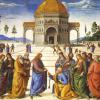Bramante, Tempietto (c. 1502)
Commentary
Donato Bramante's Tempietto (c. 1502, Italian for 'small temple') was built to mark the supposed site of St Peter's Crucifixion. This is emphasised by the altar inside (see image 2), upon which a statue of St Peter holding the keys of the Church is enthroned above a carved relief depicting his martyrdom: an upside down Crucifixion. The earliest known example of the Tuscan order (a form of Doric order) in the Renaissance, the Tempietto's columns reflect the Church's dedication to Peter, as the Doric order was theorised to be suited to the temples of strong masculine Gods.
Bramante, who moved from Milan to Rome around 1499, was surrounded by Roman ruins, which are thought to have provided the precedents for the circular design of the Tempietto:
It is situated in the cloister courtyard of the church of San Pietro in Montorio (Rome). Thanks to Sebastiano Serlio (1475-c. 1554), an Italian Mannerist architect, we know that Bramante planned to build a collonaded courtyard around the Tempietto, though this was never executed. A ground plan of his original design can be found in Serlio's Tutte l'opere d'archittetura, et prospetiua (p.67). An entire copy of the treatise, printed later in Venice in 1619, is available on archive.org.
Video: Steven Zucker and Beth Harris, 'Donato Bramante, Tempietto, Rome', available with a rich collection of further visual resources at in Smarthistory.

